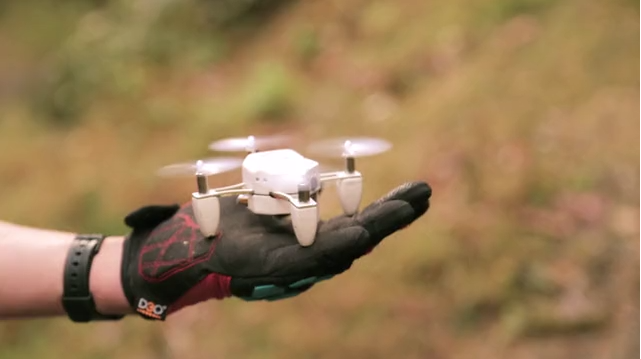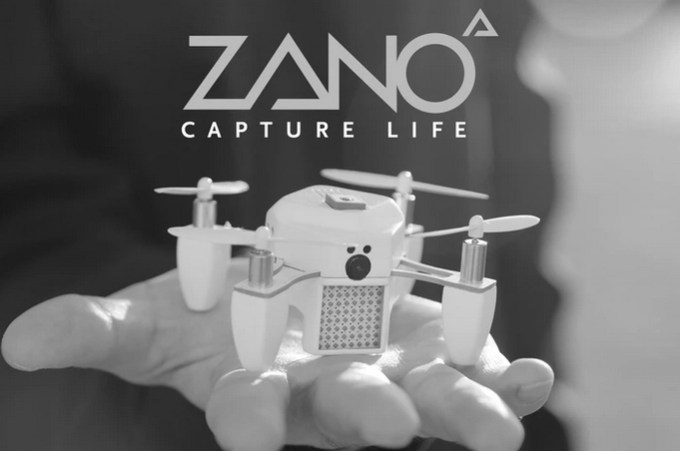At the back end of last year, it emerged that crowdfunding platform Kickstarter had commissioned a freelance journalist to report on the collapse of a high profile U.K.-based drone project that is also the highest funded European project on its platform to-date.
The journalist, Mark Harris, has now published the finished article — as a Medium post, entitled How Zano Raised Millions on Kickstarter and Left Most Backers with Nothing.
Quick catch up on the details here: the Zano selfie drone Kickstarter attracted more than £2.3 million (~$3.25M) in pledges back in 2014, from some 12,000 backers, but spectacularly failed to deliver on its promises of autonomous flight and advanced swarming features.
The handful of drones that eventually shipped lacked key features touted in the crowdfunding campaign. They even failed on basic features. The South Wales-based company filed for bankruptcy last November, leaving Kickstarter with a PR disaster on its hands.
The crowdfunding platform’s solution to this publicity nightmare was to hire an outsider (Harris) to try to get some answers, asking him to probe specific factors such as where backers’ money went, and whether the project was an out-and-out scam from the start.
But also to examine Kickstarter’s own role. Was there more it could have done to prevent Zano from biting the dust?
So what is Harris’ verdict? The tl;dr version is he does not think Zano’s creators intentionally set out to scam people but he does identify what he dubs “convincing evidence” that their Kickstarter campaign video, released in November 2014, was “misleading as to the existing capabilities and readiness level of the Zano”. He also generally concludes that the Zano team lacked the expertise to deliver what they had promised.
To my eye his 13,000-word report paints a picture of crowdfunding as an enabler for scaling ineptitude to heights it would not normally be capable of reaching — because the people involved would lack the resources to allow their inexperience to have so much runway.
One of Harris’ interviewees sums up his view of Zano’s creators as “small businesspeople who bit off more than they could chew”.
To that you could add *because they could* — having been handed the crowdfunds to do so (and thus to think they could do so).
Kickstarter co-founder Yancey Strickler concedes as much to Harris in an interview, when he asserts: “The only reason that Zano was able to raise this amount of money is because we have done such a good job administering this platform and working with trusted creators over the last six years.”
Yet it would be hard to describe the team behind Zano as ‘trusted creators’ given they failed to deliver on their promises of an autonomous selfie drone — and left thousands of backers out of pocket.
So the implication is that the trust Kickstarter’s platform has built up, enabling it to help capable people with good ideas, can also be misused to lend a cloak of credibility to inexperienced folks who frankly don’t deserve to be trusted with so much leeway. To wit: Zano.
Another salient moment in Harris’ review is another comment from Strickler about specific rules Kickstarter has forbidding photo-realistic renderings (it also forbids product simulations).
“We have these rules for no photo-realistic renderings…but practically speaking, those are hard things to enforce. The system is reliant on backers to make a decision,” he says on that.
Thing is, Kickstarter used to pre-vet all projects on its platform. But it dropped that stipulation — coincidentally or not, in June 2014, a few months before Zano’s Kickstarter took off — lowering the barrier to entry for people to launch a crowdfunding campaign by allowing certain projects to launch pre-production marketing without any human sanity-checking.
(Update: Kickstarter’s description of its 2014 change is more nuanced. It says it introduced an algorithmic “initial scan” on submitted projects at that point. “The scan determines whether the project should be able to launch right away or whether it needs human review,” says a spokesman. “The algorithm is essentially there to green-light projects like albums that are unlikely to require input from us. Our Integrity Team reviews *all* technology and design projects, because as you note these tend to be more complicated.”
Although that then begs the question: why did Kickstarter’s human reviewers green light Zano? Kickstarter has confirmed to TechCrunch that its staff did indeed review the Zano project. But evidently also failed to spot various problems with the campaign content.)
Why is this so salient? Perhaps the most interesting section of Harris’ report is where he details various problems evident in the Zano Kickstarter pitch video — the same video that managed to wow so many backers.
He sets the scene by noting that it showed “some impressive footage of the drone in action”…
Drinkers at a Welsh pub smiled as a Zano flew up and hovered over them, displaying a countdown on built-in LEDs before snapping a photo that they immediately examined on a smartphone. Zano was then shown filming rock-solid footage of a mountain biker, following a motocross rider’s gestures, and automatically returning to land at his feet. Kickstarter itself selected Zano as a Staff Pick, which gave it prominently placed promotion on the site…
However in a later section of the article Harris highlights multiple problems evident in the footage — once you take a closer look:
But the video has red flags throughout. The shots that are clearly made by a videographer and include a Zano in frame have the same characteristics as video that ostensibly was shot, or is labelled as shot, from the drone. The cliff-diving scene seems to use a lens and tracking the device lacks. The Zano is never shown in a continuous shot from take-off through flight. In one case, footage appears to be reversed (a landing is used as a take-off); in another, a shot of the Zano is likely slowed down.
In the motocross scene, effects matting is visible in the gloved hand manipulating the smartphone, which has a screen that appears too bright in the natural lighting. Together, these would suggest that the screen’s display was replaced in post-production.
Harris concludes that a “forensics investigation” would be necessary to “know for sure which parts of the video that purport to use Zano footage or show it in motion are accurate representations of what the prototype could do at the time”.
But the heavy suggestion is that a rather less forensic examination of the Zano promotional video — by someone skilled in video post-production techniques, say — would have quickly raised suspicions about the veracity of the footage. And therefore also the veracity of Zano’s claims.
Although Kickstarter has rules banning product simulations and renderings, it is effectively also leaning on backers to make their own assessment of whether a project is infringing these rules. So it requires backers to have an expert eye for video manipulations. Which is treading a pretty fine line. Most backers aren’t going to be videography experts. Yet Kickstarter’s processes effectively require such a level of expertise — at least judging by the Zano example.
Again, as Strickler puts it: “The system is reliant on backers to make a decision.”
The algorithmic changes it made to its pre-vetting process obviously allowed Kickstarter to scale its crowdfunding business, since there is no longer such a costly bottleneck constricting the flow of projects onto the platform. But it also appears to place more of the responsibility on backers to assess the veracity of projects. And therefore also to accept more of the risk.
Arguably, if Kickstarter routinely screened pitch videos, for example, either prior to launch, or even as a per-project review that takes place before the end of a campaign, enabling a suspect campaign to be pulled or more closely reviewed before backers’ money has been collected, it could better balance the distribution of risks and responsibilities. (We’ve asked Kickstarter for comment on this point and will update this post with any response.)
As it stands, some sanity-checking responsibility clearly falls to backers — who are able to click a button to report a project they believe might be suspect.
However one of Harris’ key criticisms of Kickstarter is that this ‘Report this Project’ button is positioned “at the very bottom of each Kickstarter page… vague and easy to overlook”.
“I would suggest replacing it with a Convince Me button in a prominent location,” he writes. “If enough registered users click on this, the project would receive additional scrutiny from the platform’s Trust or Integrity teams. (Also, platforms should fund robust Trust and Integrity teams.).”
Emphasis on the word ‘robust’ there — given Kickstarter’s integrity team evidently did not identify problems with Zano. A spokesman for the platform says the checks this team makes are supposed to see whether projects meet some basic rules, and also — for hardware projects specifically — show a working prototype with no computer-generated images or simulated products. Yet Zano was undoubtedly simulating in its pitch video. So those integrity checks failed in this case.
Harris personally concludes: “I do not believe that the creators possessed the technical or commercial competencies necessary to deliver the Zano as specified in the original campaign.”
And the key word there is ‘competencies’. It’s one thing to crowdfund a music album, a book of poetry or a work of art. It’s quite another to deliver a complex piece of technology just because you had an idea for a drone that can fly autonomously and do some other cool stuff. Ideas are cheap, technology is hard. And hardware is especially hard.
Yet inexperienced business people lacking substantial technical expertise are being set up for failure by the relative ease of crowdfunding success. Bottom line: Marketing is a *whole lot easier* than making.
And so while Zano’s marketing campaign was spectacularly successful — soaring to huge heights, thanks to the reach and exposure of Kickstarter’s platform — the actual Zano drone was junk. Perhaps one of the worst drones money could buy you…
[One of the very few backers who did get a Zano] Holloway’s drone, hand-delivered to him at launch, updated to the latest software, and fine-tuned personally by the company’s founder, was probably the best Zano in the world. And yet it still lacked the features and reliability of many cheap toy quadcopters from China.
Ouch.
Harris ends the piece with this series of recommendations for how Kickstarter should handle hardware projects and/or those pulling in large amounts of funding in future:
- Kickstarter, and other crowdfunding platforms, should reconsider the way that they deal with projects involving complex hardware, massive overfunding, or large sums of money. There should be better mechanisms to identify weak projects before they fund, as well as new processes to provide mentorship, support and expert advice to newly-funded projects.
We’ve asked Kickstarter if it intends to make any changes to its processes in light of his report, and will update this post with any response.
A spokesman has now provided the following statement to TechCrunch:
We have analysts who screen projects before they launch, and we also rely on our community to flag things they see that may be violations of our rules. We don’t hesitate to suspend projects that are violating our rules, as was the case with Skarp. But as Yancey notes, on a practical level, some manipulations are going to get through, and in the end it’s up to backers to judge whether a project is worth supporting. There are always going to be risks involved in supporting projects on Kickstarter. We helped with a study that we hope will help backers understand those risks. We commissioned Mark’s report in that same spirit of transparency. And we believe, as Mark does, that the upside is worth it: “If we want a democratic, open, freely accessible alternative to banks and venture capitalists, then we will have to accept occasional failures like Zano along with runaway successes like Pebble, Oculus Rift, and Veronica Mars.”

































Comment